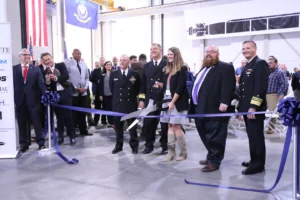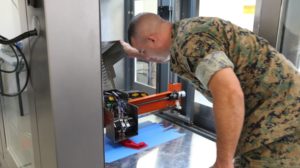The Navy opened a new Additive Manufacturing (AM) Center of Excellence (CoE) within Virginia’s Center for Manufacturing Advancement (CMA) that aims to help accelerate and scale up AM while also centralizing the Navy demand signal for the industrial base.
Additive manufacturing, also known as 3-D printing, allows the production of lighter parts, custom parts, and rapid prototyping.
This new Center of Excellence is located on the Danville, Va., campus of the Institute for Advanced Learning and Research (IALR), and co-located with the institute’s Accelerated Training in Defense Manufacturing (ATDM) program. The Navy is becoming the first project partner with the CMA, which was funded with almost $29 million in state funding.

The ATDM program, in turn, is already a joint Navy-Office of the Secretary of Defense industrial base analysis and sustainment effort “that provides a fast track, intensive, and targeted curriculum across key trades, including welding, machining, metrology, and additive manufacturing,” the Navy said in a statement.
According to the Navy, this center of excellence will have three full bays aimed at “accelerating and scaling additive manufacturing, activating the supply chain through a centralized Navy demand signal, and serving as an operational hub that builds upon experience and collaboration across a consortium of industry and academic experts.”
Austal USA also announced it will lead a consortium of AM experts at the center of excellence, providing program management and oversight of developmental and production efforts.
Other members of the consortium include the Phillips Corp., Industrial Inspection & Analysis, Inc., the IALR, FASTech Inc., the Virginia-based Commonwealth Center for Advanced Manufacturing public-private partnership applied research center, University of Virginia, and The Spectrum Group.
Austal noted it was made head of the consortium after it worked with submarine builder General Dynamics’ Electric Boat [GD] to help construct and outfit command and control system modules and electronic deck modules.
The company said the Navy established CoE to design a ‘build-to-print’ capability that is aimed at long-lead time parts to reach schedule adherence and build production reserves as well as trying to add new entrants to the submarine industrial base.
Austal said this will ultimately contribute to recapitalizing and delivering Virginia-class attack submarines (SSNs) and Columbia-class ballistic missile submarines (SSBNs). The center will help these goals by developing qualified part recipes that will transition to industry for serial production.
“A key aspect of the CoE is the consolidation of Navy-dedicated printing, [non-destructive testing], and metrology capabilities under one roof. The CoE will also focus on exploiting AM for distributed production, working to bring new entrants to the submarine industrial base while also supporting forward-leaning casting foundries looking to adopt AM to bolster their production volume,” Austal said in a statement.
While additive manufacturing and non-destructive testing initially occur using consortium member’s in-house capabilities, production is expected to gradually ramp up at the center of excellence in its first year.

“The CoE will execute end-to-end production and achieve full operational capability in late 2023,” Austal said.
During the event, Matthew Sermon, Executive Director of the Program Executive Office, Strategic Submarines (PEO SSBN), said the creation of the AM CoE “marks the first major partnership for the CMA, and demonstrates the Navy’s commitment to investing in – and delivering – the skilled workforce necessary to strengthen and expand the Navy’s industrial base to achieve the Nation’s strategic defense objectives.”
“Building and sustaining the Navy’s defense industrial base workforce, and smartly but aggressively pushing the bounds of advanced technology adoption, has become a national security imperative and is part of the whole-of-government/whole-of-industry approach. This facility, and the partnerships it is built upon, will pave a path for sustainable and scalable additive manufacturing production capability in the submarine industrial base, and across the Navy-industry community,” he continued.
Sermon also noted it has been almost 40 years since the U.S. recapitalized the SSBN capability and added equivalent volumes and work complexity into the industrial base for that effort.
“At every level in the Navy’s industrial base…workforce, technology, and the space where those two converge…are an absolute requirement for success. In cutting the ribbon today on the AM CoE, with partners like Austal USA and the other forward-leaning industry and academic leaders paving this path, we are securing our ability to innovate and execute faster and better than our adversaries, and that will be a fundamental differentiator in our future competitive landscape,” Sermon added.
Rear Adm. Scott Pappano, Program Executive Officer for SSBNs, cut the ceremonial ribbon and announced related specific plans for investments in dedicated infrastructure, capability, and capacity designed to scale the current ATDM program via a Regional Training Center.
This regional training center will be adjacent to the AM CoE and seeks to have the capacity to train about 1,000 defense manufacturing workforce members annually.
“ATDM serves as a national model for how we meet the demand for industrial base workforce over the coming years. As we look to our greatest threats and risk, we must make bold moves…that’s exactly what we are doing here in Danville,” Pappano said.